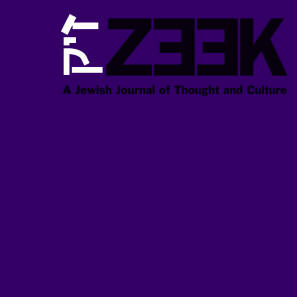 November 06
November 06
Kashrut and Nonduality
by Jay Michaelson
p. 2 of 2
Really, the most revolutionary principle of this form of Jewish religion
is not any particular rationale, but that the rules exist at all in the material,
practical form that they do. Today, we Jews are often a bit embarrassed that
two sets of silverware are somehow religiously significant. But let’s take it
seriously. The core underlying assumption, behind any form of physical religious
prohibition which does not have a stated psychological, metaphysical or moral
"reason," is that body, itself, matters. Not because it can calm the mind, or make
us feel good. Not because it curbs our dangerous appetites. And not because of
health. But really, for its own sake, even if it gives no emotional, intellectual, or
spiritual benefit whatsoever. Actions, not intentions and not "spiritual"
consequences, are themselves of religious value.
Rather than search for a "spiritual meaning" to the rules of kashrut, I
prefer to see the practice as purely a matter of materiality. And rather than
search for an intellectual justification for the particular laws (Mary Douglas's
analysis in Purity and Danger - roughly the "ancient taboo" line from above -
seems to me the most lucid, though it has little application to a contemporary
consciousness), I have learned to regard them as arbitrary - and yet critically
important precisely because they are arbitrary, non-"spiritual," and devoid of
emotional meaning. Why? Because without those embellisments, kashrut is a
body practice, and recognizes the value of the body, of the material world, on its
own.
Let’s take the implications of "body practice" one step further. Most of
us, I think, are conditioned to believe that the body is merely a tool to affect
some non-embodied "spirit." There is a historical reason for this belief: it was
one of the main sites of disagreement between Talmudic Jews and the early
Christian Jews, led by Paul. Paul saw the body as flawed, fallen, and mortal; the
soul, in contrast, was pure, capable of salvation, and immortal. How could
circumcision of the flesh have any meaning, when circumcision of the heart was
so much more important? Paul, Christianity, and Platonic dualism have so won
the day that I think most of us take for granted that religion is a matter of heart
and soul, and that religious practices exist only to bring about "spiritual"
changes.
But the Talmudic sages disagreed. They argued, in their version of the
"New Testament," the Mishna (literally: "Second"), that the significant sphere
of religious life was the body, not the disembodied soul. This is why "pointless"
embodied commandments such as kashrut are discussed in such intimate,
endless detail: because the body is the point.
If we try to make each detail of legalistic Judaism conform to some
higher "spiritual" purpose, most of us will get very frustrated. On the other
hand, if we approach the minutiae of kashrut as configuring the physical
universe in a holy way - not because of how it makes us feel, but because of how
it physically is, in itself - then we are liberated from the yoke of needing each
act to be spiritually fulfilling and we find ourselves in a place of honoring the
physical bodies we inhabit. Your body is of importance; thus even the details of
frying an egg are important as well, whether the ego feels it or not. Halacha, the
Jewish "path," exists trans-subjectively - that is, beyond the sensations it brings
about.

All of this rather traditionalist conversation accords quite neatly with
the nondual revolution in the realm of the spirit. In such a view, the soul is not
a feeling, not a faculty in addition to the body, mind, and heart; it is the point of
connection between those aspects of the self and the reality of the One. Feelings
are part of the picture, but the true "goal" of spiritual practice is to embrace all
of the parts, on their own terms. To be sure, nondual practice is advanced
practice, because a colorless, feeling-less truth is only attractive for those who
have first tasted the ecstasies and joys of contemplative life. First, taste the
energies, know them, drink them in - and know that they are real, that several
thousand years of hidden wisdom are not, actually, all made up. But as you
come to know the delights of form, complement yesh (form) with ayin
(emptiness); come to know that they are all one taste.
In the context of One Taste - Ken Wilber's term for the omnipresent
consciousness of the Divine, what the Hasidim would call devekus - both kashrut
specifically and Jewish practices generally take on a new cast. If we only perform
those rituals that give us a certain feeling, then we are mistaking a certain feeling
for God. This is what I have called the "idolatry of yesh." In fact, the Infinite is
truly infinite, not just in the places we enjoy. God is in the fire, in the wind, in
the still, small voices which nurture us at night - and in the physical body as well.
In this light, kashrut, as with circumcision, technical Sabbath observance, and
hundreds of other Jewish rituals, extends the infinite into the realm of the
finite. It refuses to say that the material world is fallen, or irrelevant, or only
important because of its effect on the "soul," whatever that is. It sanctifies the
ordinary not by creating a special feeling, but simply by being.
And then, in my experience, feelings do arise. What I have experienced,
when I am able to practice this way, is a different sort of love from the one I
read about in books. It is an egoless, transparent love which inheres in the actual
food I put in my mouth, in the actual stomach which digests it, and in the actual
nutrients absorbed by my bloodstream. And it is an embrace that holds me even
when I do not feel it, even when I do not want to be held. It is as inescapable as
an Infinite Being should be: always with me, always touching every atom of my
being, just waiting for me to wake up.
The non-duality of the embodied self leads to an enlightenment far
deeper than the dualistic flight from the body. Holding onto a separation
between the body and the soul, it's easy to imagine a soul independent from the
rest of the world, like a puppetmaster pulling the strings of our body: an
autonomous, separate "soul," apart from the body, and the seat of our actual,
separate essence. But this whole picture is simply not true. What we call "the
soul" is actually a net of causes and conditions determined by genetic
information, environment, culture, society, and the myriad "accidents of living"
we encounter. Consciousness, a trick played by a well-functioning brain, is not
some immaterial puppetmaster pulling strings; it's a result of decades of data,
and millennia of genetic evolution. Of course, there are so many of these
factors that none of us can keep track. No one can predict how a boy will grow
into a man, and thus no one but that man is responsible for his conduct and
destiny. But ultimately, if we really look at the causes of every act and decision,
we will see that none of them spring from nowhere. Everything has its
conditions, including your reading, my writing, and the sounds around you right
now. In fact, since everything is fully dependent upon those conditions, you
might ask: who really is reading, who really is writing, and what really is going
on?
Some people worry that, without immortal, immaterial souls, we are
merely machines, with no accountability and no humanity. But neither
consequence is true. Actually seeing oneself as a "machine," that is, as a body
governed by the laws of the universe, is not a diminishment; it is a release from
the delusion that who you are is this small self, separate from the rest of the
universe, a soul trapped in a body. Precisely the scientific materialism so
derided by many religious and spiritual people is the key to enlightenment itself.
You are not a "soul" unfortunately trapped in a body. You are starstuff (in Carl
Sagan's words), and your mind is a temporary repository of the dreams of the
universe.
The great spiritual achievement is not transcending the body, but as
joining body and spirit together. Only then can form be dissolved in emptiness,
and emptiness manifest as form; as long as the body is thought of as something
to be negated, then, from a contemplative perspective, there is still more desire
and fear to let go. And from a religious perspective, a gnostic denial of the
reality of the manifest world cannot coexist with a monotheistic understanding
of a God known in creation. Are all the world’s delights, all its sorrows, and all
its manifold forms of beauty merely a temptation for the unfortunately
imprisoned soul? Are they a waste of God’s (and our) time? Or is it all, in the
end, a world devoid of significance, with beauty being a matter of mathematics
alone, and with love a mere accident of neurology?
The truth does set you free; the release from the incorrect assumptions
that what seems (i.e. the self) is what is, is simultaneously the release from the
overzealous godwrestling which sees the world in terms of what I have, and
what I don’t yet have but want. Just let it go, for God’s sake - the treadmill of
inadequacy, craving, and stress is not doing you or the planet any good. Sure,
the yearning is often righteous, for justice and equity and the rest. But more
often, it churns the engines of consumption, turning even nourishment into
industry.
Integration, however, is essential, and that is where the materiality of
kashrut rescues the practice from historical artifact and ascetic sublimation. To
return to a favorite image of mine, the six-pointed Jewish star has two triangles,
one pointing upward - toward heaven, transcendence, ayin, the emptiness of the
Infinite - and another pointing downward, toward the earth, Immanence, yesh,
and the endless varieties of experience. The goal is not to privilege one triangle
over the other - to flee the material world in favor of the spiritual one, or vice
versa. It is the sacred marriage of the two. This union has many iterations: body
and spirit, earth and sky, experience and theory, the Presence and the Holy
One, feminine and masculine, immanence and transcendence, substance and
form, the many manifest energies of the world and their ultimate, essential
unity. On the plane of ayin, the entire cosmos really is all in your head - only, it
isn't your head. On the plane of yesh, the physical is as real as the "spiritual."
And both planes are true.
As long as the individual self still believes that its dispositions are the
barometers of the Infinite, the idolatry of the yesh, of form, endures. Liberation
cannot happen if spiritual practice is about feeling good, or mystical, or special.
Yet it's the simplest, most obvious thing in the world when the desires for those
feelings are released, and the world is sufficient as it is: perfect, and up to you to
make it better. Then the ego drops, the body is real (as real as anything, that is),
and the real work at last can begin.
Jay Michaelson is the chief editor of this magazine and the author of God in Your Body: Kabbalah, Mindfulness, and Embodied Spiritual Practice. A version of this article appears in the Zeek print edition.









